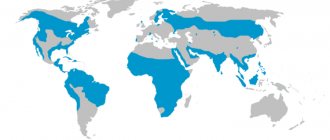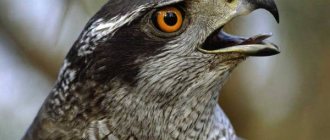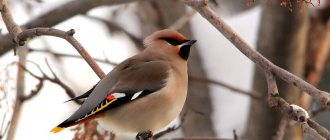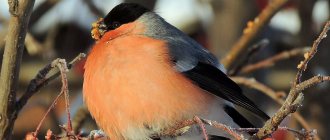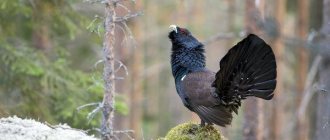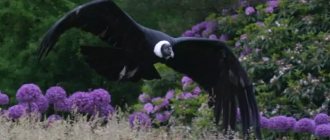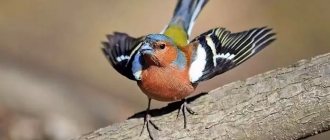- Wild animals
- >>
- Birds
The griffon vulture is a rare type of vulture of impressive size with a wingspan of up to 3 m, and is also the second largest bird in Europe. It is an Old World vulture and a member of the predatory hawk family. It takes off majestically from thermal currents in search of food in the warmer, harsher parts of the countries surrounding the Mediterranean Sea.
Origin of the species and description
Photo: Griffon vulture
The griffon vulture is an Old World vulture of northwestern Africa, the Spanish Highlands, southern Russia and the Balkans. Gray above and reddish-brown streaked with white below, this bird is about a meter long. The vulture genus contains seven similar species, including some of the most common vultures. In South Asia, three species of vultures, the Asian griffon vulture (G. bengalensis), the long-nosed vulture (G. indicus), the common vulture (G. tenuirostris), are close to extinction by feeding on the carcasses of dead livestock given painkillers; painkillers cause kidney failure in vultures.
Video: Griffon Vulture
Interesting fact: The long, bare-necked griffon vulture is the result of the evolution of birds that use their beaks to open the carcasses of dead animals. The absence of feathers on the neck and head makes this process easier. A few years ago, a spy vulture was caught in Saudi Arabia bearing traces of a Tel Aviv University GPS sensor. This event led to an increase in avian spying.
They are noisy birds that communicate using a wide range of vocalizations, for example hisses and grunts can be heard when feeding, while tree chatter is made when another bird is covered.
Large wings help these birds soar high in the air. This helps them conserve energy that would be wasted if they flapped their wings. Their exceptional vision helps them spot carrion high in the air. Griffon vultures can thermoregulate without the aid of metabolism, allowing them to limit energy and water loss.
Notes
- Boehme R. L., Flint V. E.
Five-language dictionary of animal names. Birds. Latin, Russian, English, German, French / Under the general editorship of academician. V. E. Sokolova. - M.: Rus. lang., “RUSSO”, 1994. - P. 43. - 2030 copies. — ISBN 5-200-00643-0. - ↑ 1 2 V. N. Ivanenko.
[nature.ok.ru/doc/birds/2_49.htm Griffon Vulture Gyps fulvus].
Rare and endangered animals of Russia
(inaccessible link -
history
). nature.ok.ru. Retrieved October 25, 2008. [web.archive.org/20000819042238/nature.ok.ru/doc/birds/2_49.htm Archived from the original on August 19, 2000]. - [www.iucnredlist.org/details/144353 Gyps fulvus] (English). IUCN 2008 Red List
. IUCN. Retrieved October 25, 2008. [www.webcitation.org/66IrHIl7h Archived from the original on March 20, 2012]. - [www.biodat.ru/db/rb/rb.php?src=1&vid=291 Griffon vulture Gyps fulvus]. The Red Book of Russia
. BioDat. Retrieved October 25, 2008. [www.webcitation.org/66IrIgoaS Archived from the original on March 20, 2012]. - ↑ 1 2 James Ferguson-Lees, David A. Christie.
Raptors of the World. - Princeton: Princeton University Press, 2006. - P. 122. - 320 p. — ISBN 0-691-12684-4. - ↑ 1 2 3 4 5 6 7 G. Dementyev, N. Gladkov.
Birds of the Soviet Union. - Soviet science, 1951. - T. 1. - Killian Mullarney, Lars Svensson, Dan Zetterström, & Peter J. Grant.
Birds of Europe. - Paperback. - Princeton: Princeton University Press, 2000. - P. 72. - 400 p. — ISBN 978-0-691-05054-6. - L. S. Stepanyan.
Abstract of the ornithological fauna of Russia and adjacent territories. - Moscow: Akademkniga, 2003. - 808 p. — ISBN 5-94628-093-7. - Stavros M. Xirouchakis, Moysis Mylonas.
[www.ingentaconnect.com/content/miiz/actao/2005/00000040/00000002/art00009 Selection of breeding cliffs by Griffon Vultures Gyps fulvus in Crete (Greece)] // Acta Ornithologica. - 2005. - T. 40, No. 2. - P. 155-161. - ↑ 1 2 I. Karyakin.
[ecoclub.nsu.ru/raptors/species/gyps_ful.shtm Griffon Vulture (Gyps fulvus)].
Nature of Southern Siberia and its defenders.
Species essays. . Server of public environmental organizations of Southern Siberia. Retrieved October 27, 2008. [www.webcitation.org/66IvtaINR Archived from the original on March 20, 2012]. - ↑ 1 2 3
[www.wildsideholidays.com/natural/birds/72-birds-of-iberia/102-griffon-vulturegyps-fulvusbuitre-leonardo Griffon vulture (Gyps fulvus) Buitre leonardo].
Birds of Iberia
. Wildside Holidays. Retrieved October 27, 2008. [www.webcitation.org/66IvuZsYl Archived from the original on March 20, 2012]. - ↑ 1 2 M. Leconte, J. Som.
[cat.inist.fr/?aModele=afficheN&cpsidt=3172351 The Griffon Vulture Gyps fulvus breeding in the eastern Pyrenees: History of recovery of a population and breeding parameters] (French) // Congrès. - 1996. - Vol. 64, no 2. - P. 135-148. - E. A. Nazarenko, S. A. Bessonov.
[www.sevin.ru/vertebrates/index.html?Birds/164.html Gyps fulvus (Hablizl, 1783) - Griffon vulture].
Vertebrates of Russia: a review
. Institute of the Russian Academy of Sciences named after. A. N. Severtsova. Retrieved October 27, 2008. [www.webcitation.org/66Ivvy5uR Archived from the original on March 20, 2012].
Appearance and features
Photo: What a griffon vulture looks like
The upperparts of the griffon vulture are dark brown and the wings are quite dark with black flecks. The tail is short and black. The underparts vary in color from brown to reddish brown. The long naked neck is covered with short creamy white down. At the base, behind the neck, the absence of feathers leaves a bare purple patch of skin, similar to those he sometimes voluntarily displays on his chest, and which is a reflection of his coolness or his excitement, turning from white to blue and then red, depending from his mood.
Ripples of white or pale brown feathers appear around the neck and on the shoulders. Golden-brown eyes animate the head, which is equipped with a powerful and pale hooked beak designed to tear flesh apart. Immature individuals have the silhouette of adults, but are darker. It will take them four years to gradually develop adult plumage.
The flight of a griffon vulture is a true demonstration of virtuosity. He takes off for long moments, barely moving his wings, almost unimaginable and measured. Long and broad, they easily carry this body of clear color, contrasting with the darker primary and secondary feathers. When a bird takes off from the ground or a steep wall, it performs slow, deep wing strokes where air rushes in and lifts the predator. The landing is as fine as her approach, with the wings effectively slowing down the strike and the paws kept away from the body, ready to touch the stone.
Rostov region
Status: III category. A very rare vagrant.
Spreading
In the Rostov region. Only a few cases of migration are known: at the end of August 1878, a vulture was encountered near the city of Taganrog; at the beginning of September 1909, 2 birds from a flock of 8–9 individuals were killed in the Don delta; in the autumn-winter period of 1991, a single vulture was repeatedly observed in the Tatsinsky district; during the snowy winter of 1996/97, up to 10 vultures stayed for about a month on carrion and the remains of deer in hunting areas in the Alexander Forest in the Azov region; at the beginning of October 1999, a vulture, possibly having flown away from captivity, was observed on the roof of one of the buildings in Rostov-on-Don.
Number
To the Rostov region. very rarely individuals or small groups fly in.
Source: Red Book of the Rostov Region. Volume 1. Animals. Ed. SOUTH. Arzanov, G.B. Bakhtadze, V.P. Belik et al. (2014) Rostov-on-Don, Ministry of Natural Resources of the Rostov Region
Where does the griffon vulture live?
Photo: Griffon vulture in Russia
In nature, the griffon vulture lives in the mountainous and hilly regions of North Africa and southern Eurasia. It can live at 3000 m above sea level.
There are two recognized subspecies of griffon vultures:
- nominal G.f. Fulvus, which extends throughout the Mediterranean basin, from northwestern Africa, the Iberian Peninsula, southern France, including the islands of Mallorca, Sardinia, Crete and Cyprus, the Balkans, Turkey, the Middle East, Arabia and Iran to Central Asia;
- subspecies G. f. fulvescens is found in Afghanistan, Pakistan and northern India to Assam. In Europe, it has been successfully reintroduced in several countries where it had previously disappeared. In Spain, the main population is concentrated in the northeastern quadrant, mainly in Castile and Leon (Burgos, Segovia), Aragon and Navarre, north of Castile-La Mancha (north of Guadalajara and Cuenca) and eastern Cantabria. In addition, there is a significant population in the south and west of the peninsula - in the mountains of northern Extremadura, south of Castile-La Mancha and several Andalusian mountain ranges, mainly in the provinces of Jaén and Cadiz.
Currently, Eurasian griffon vultures breed in Spain and the Grand Cause in the Massif Central (France). They are found mainly in Mediterranean zones, nesting locally in the Balkans, southern Ukraine, the Albanian and Yugoslav coasts, reaching Asia through Turkey and arriving in the Caucasus, Siberia and even Western China. They are rare in northern Africa. The main population of Europe is the population of Spain. Extremely protected, subject to successful reintroduction in France, this species is however threatened by various threats.
The reasons for this are numerous:
- the harsh climate of a high mountain causes the death of chicks;
- nest predation and removal of eggs and chicks;
- livestock in the wild are dwindling and not producing enough carcasses for colonies;
- Current medical regulations requiring the burial of dead animals deprive predators of these resources;
- poisoned pieces of meat intended for foxes and fatally consumed by vultures who die because of it;
- electrical lines;
- lost pieces of lead shot.
Now you know where the griffon vulture lives. Let's see what he eats.
Altai region
Status: III category. Rare view.
Spreading
Rare cases of the appearance of stray birds, sometimes together with vultures, were cited in the literature in the mountainous part of the Altai Territory. It should be noted that recently some of the birds noted at different times by different observers may not belong to this species, but to the Kumai, since distinguishing these twin species in nature is often problematic. Thus, in the near future, efforts must be made to obtain unambiguous answers to the questions that have arisen in the situation with the “sipami-kumai” in the Altai Territory.
Number
The region is constantly inhabited by a small number of stray birds, the number of which can number in the dozens.
Source: Red Book of the Altai Territory. Volume 2. Rare and endangered species of animals. Ed. N.L. Idrisova, E.V. Shapetko (2016) Barnaul: Altai University Publishing House
What does the griffon vulture eat?
Photo: Griffon vulture in flight
A griffon vulture discovers its food while in flight. If the potential prey senses a light breeze, it will use this to fly away. If the sun is hot, the griffon vulture flies into the sky until it becomes inaccessible. There he flies for hours, keeping his eyes on the ground, with other vultures, who, with the slightest change in attitude or flight, may reveal a dead animal that will give them food.
At this moment, he descends and approaches with other vultures, hovering over the area above the carrion. They then begin continuous turns where each one watches the other without deciding to land. In fact, Egyptian vultures and corvids often arrive first and eat the softer parts of the prey. Griffon vultures then establish their hierarchy by coming from different locations to congregate in the same restricted area. Some of them dive without landing, while others circle in the sky.
Finally, one of them lands far from the frame, about a hundred meters away. The rest follow very quickly. Then the struggle for hierarchy and temporary dominance over others begins. After several arguments and other displays of intimidation, the vulture, which is bolder than the others, heads straight for the carcass, where the now dominant vulture opened its belly and began to eat the entrails.
Interesting fact: Griffon vultures feed exclusively on carrion. They never attack a living creature and can live for a long time without food.
The griffon vulture plays a unique role in the food chain, making it indispensable. It specializes in eating dead animals and thus prevents the spread of disease and promotes a kind of "natural recycling".
Lifestyle
The vulture bird has a calm and self-possessed character. Conflicts between individuals can arise only when dividing up prey. Barn owls treat other birds calmly. Vultures are very mobile and agile, despite their large body. In flight, they prefer to soar calmly, lowering their heads and retracting their necks. They flap their wings rarely and slowly, while using the flow of warm air from the heated ground and saving their energy. Birds form monogamous pairs that remain faithful to each other until the end of their days. They nest in small groups of up to twenty pairs. They are distinguished by their long life expectancy, which is up to fifty-five years.
In search of food, birds are active only during the daytime, and are often forced to violate neighboring boundaries. They can gather in large flocks near large prey. The weak legs of the vulture are not able to carry prey on the fly, so food is eaten on the ground. Hunting forces them to soar in the air alone for hours, patiently and carefully looking out for prey. It is easier for a bird to rise into the air from an elevated place than from the ground. Clean birds often clean their plumage and bathe, especially after eating.
Features of character and lifestyle
Photo: Griffon vulture bird
Flight displays are an important period in the life of a griffon vulture. These flights take place in November-December and are an unforgettable sight for those who have the chance to see them. Even if these displays are not as beautiful as those of other raptors, they are a sign of the short dives both birds make together as one chases the other during the early breeding season. These flights can occur throughout the year, and often collect other birds that join the previous ones.
At high altitude, a pair of griffon vultures circle slowly, with wings spread and stiff, close together or so well overlapped that they appear to be connected by an invisible wire. Thus they fly through the sky, in brief moments, following each other or flying parallel, in perfect harmony. This spectacle is called “tandem flight.”
During this period, griffon vultures sleep where the future nest will be built. They nest in colonies, gathering in several pairs to nest in the same area. Some colonies can contain hundreds of pairs. They are located at different altitudes, sometimes up to 1600-1800 meters, but usually they are located at about 1000-1300 meters.
Interesting Fact: A very sociable species, the griffon vulture forms large stripes according to its numbers in given areas. They are often found in the same location as the breeding colony, or quite close.
Griffon vultures build their nest in a stone cavity that is difficult for humans to access. It is made from medium-sized sticks one or two centimeters in diameter, grass and more beautiful branches. The nest differs from one griffon vulture to another and even from year to year within the same pair. It can range from 60 to 120 centimeters in diameter. The interior may be with a depression well lined with grass, or just a plain one with a depression lined with the feathers of other vultures found in a nearby roost. The decoration changes as well as the character of the owner.
The Republic of Dagestan
Status: III category. Rare view.
Spreading
Found nesting in the foothills and inland mountainous regions of Dagestan. Nesting in the highlands of the Main Caucasian and Bokovoye ranges has not yet been proven, but it is constantly found in these territories during the nesting period. Nomadic birds are observed throughout the region, from the highlands to the Nogai steppe and the lower reaches of the Kuma River.
Number
Estimates of the species' abundance in Dagestan at the end of the 1990s range from 20-30 to 100-120 pairs. The current number is estimated to be slightly higher - up to 120-150 pairs, but this is due to better knowledge of the species as a result of research in recent years. No noticeable fluctuations in numbers have been noted in recent years.
Source: Red Book of the Republic of Dagestan. Ed. Abdurakhmanov G.M., Magomedov B.I., Magomedov R.D., Sharipov A.R., Abdusamadov A.S. (2009) Makhachkala, Ministry of Natural Resources and Environmental Protection of the Republic of Dagestan
Social structure and reproduction
Photo: Griffon vulture in Crimea
The female griffon vulture lays only one white egg, sometimes in January, or more precisely in February. Both partners take turns incubating one egg at least twice a day. The changes are very ceremonious, the predators make very effective slow and careful movements.
Incubation lasts from 52 to 60 days. The chick is very weak at hatching, with little fluff, and weighs about 170 grams. The first days of their life are dangerous because they are hatched in the mountains and at relatively high altitudes. At this time of year, snow is abundant and many chicks cannot withstand these harsh conditions, despite the attention of their parents.
Fun fact: The griffon vulture loves the sun and hates the rain. This is why parents constantly breed chicks and take turns regularly.
At three weeks of age, the chick is completely covered in dense down, and its weak first calls become stronger. The parents feed him a regular pasty diet during the first few days. Two months later he already weighs 6 kg.
At this age, young individuals have a special reaction if they are threatened or even captured. He vomits directly a large volume of digested meat. Fear of reaction or aggressiveness? On the other hand, it does not defend itself against intruders and does not bite, although, true to its parents' mood swings, it can be aggressive at times. The feathers appear in about 60 days and then very quickly become adult-like.
Four full months are needed for a young vulture to finally fly free. However, he is not completely independent and his parents still feed him burp. The young often follow the adults in search of food, but they do not land near carcasses, preferring to return to the colony and stay together until their parents return and feed them generously.
After the breeding season, griffon vultures, which breed in the northern part of their range or in the highlands, move south, but rarely over very long distances. The majority, however, seem to be sedentary.
Republic of Crimea
Status: III category. Rare view.
Spreading
Sedentary and nomadic species; Birds from other populations are known to migrate to Crimea. Inhabits steep areas of rocky massifs up to 1200 m above sea level. u. m. Protected in the Crimean and Karadag natural reserves
Number
The total number is 100–130 individuals, nesting number is 15–20 pairs.
Source: Red Book of the Republic of Crimea. Animals. Rep. ed. S.P. Ivanov, A.V. Fateryga (2015) Ministry of Ecology and Natural Resources of the Republic of Crimea. IT ARIAL LLC, Simferopol
Natural enemies of griffon vultures
Photo: Griffon vulture
Griffon vultures have no predators. But the threats it faces are of particular interest. Their greatest threat currently is collisions with power lines and vehicles as they hover in search of food, as well as poisoning.
When a farm animal dies, the farmer can poison the carcass to get rid of unwanted predators on the farm (such as jackals or leopards). These poisons are indiscriminate and kill anything that eats meat. Unfortunately, this vulture is also hunted for muti (or traditional medicines that are part of the witchcraft culture).
Some farmers have become involved in protecting griffon vultures and increasing their chances of survival by creating "restaurants" for the birds. For example, when one of their cattle dies, the farmer will take the carcass to the "restaurant" and leave it there so the barn owls can dine in peace.
In the Serengeti, for example, kills of predators on which griffon vultures fed account for 8 to 45% of carcasses, with the remaining carcasses coming from animals that died from other causes. But since the vultures received only a very small amount of food from the killings of predators, they had to rely on their food supplies, mainly on carcasses that were obtained from other sources. Thus, these vultures utilize fundamentally different food supplies from predators and have likely evolved into scavengers of migratory ungulate populations.
Interesting Facts
Barn owls kill bacteria on their feathers by spreading their wings and exposing them to ultraviolet light.
The increased acidity of the gastric juice of birds neutralizes cadaveric poisons from food.
The vulture is considered an excellent flyer, reaching up to sixty-five km/h in flight, and up to one hundred and twenty km/h when diving down from a height.
Wild vultures help detect gas leaks in gas pipelines, thanks to a substance reminiscent of the smell of carrion that is added to the gas.
Population and species status
Photo: What a griffon vulture looks like
The total griffon vulture population size is estimated to be 648,000-688,000 mature individuals. In Europe, the population is estimated at 32,400-34,400 pairs, representing 64,800-68,800 mature individuals. Overall, the species is currently classified as Least Concern and its numbers are increasing today. In 2008 there were approximately 30,000 breeding pairs in Spain. Most of Europe's population lives here. In Castile and Leon, about 6,000 couples (24%) make up almost a quarter of the Spanish population.
After a population decline in the 20th century as a result of poisoning, hunting and dwindling food supplies, the species has increased sharply in recent years in some areas, especially Spain, the French Pyrenees and Portugal. In Europe, the breeding population is between 19,000 and 21,000 pairs, with approximately 17,500 pairs in Spain and approximately 600 in France.
Illegal use of poison is a leading cause of unnatural griffon vulture deaths, along with accidents caused by power lines. Some wind farms located in areas close to feeding areas and migration routes have high mortality rates. The griffon vulture's long reproductive period makes it very sensitive to disturbances caused by sporting activities.
Due to its extensive breeding range and large population, the griffon vulture is not considered globally threatened. However, it faces several threats, such as farmers placing poisoned carcasses to control predator populations. Further major threats include improved agricultural hygiene and veterinary care, meaning fewer pets die and fewer opportunities for vultures. They also suffer from illegal shooting, interference and electrocution on power lines.
Kabardino-Balkarian Republic
Status: 05/28/2004 the species was added to the list of flora and fauna objects included in the Red Book of the Kabardino-Balkarian Republic approved by the Government of the Kabardino-Balkarian Republic.
Spreading
A sedentary species, some individuals can make significant migrations. Nesting sites are rocky cliffs along river valleys or cuesta ridges in mountainous areas with a combination of forests, meadows or desert areas.
Source: Specially protected natural areas of the Russian Federation. Protected Areas Database

